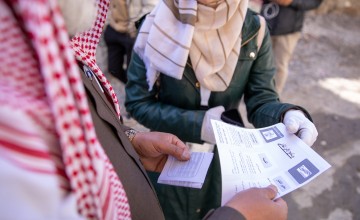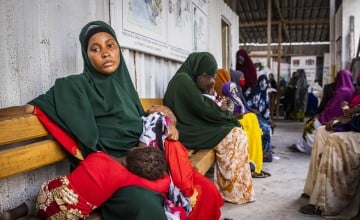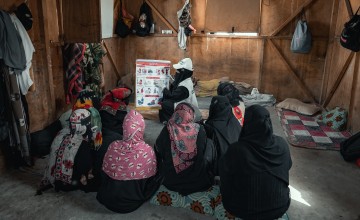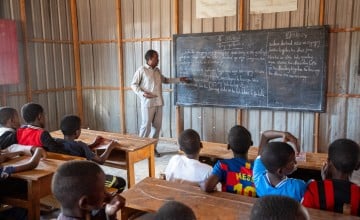
Read our 2024 annual report

Knowledge Hub
Approximately 700 million people around the world live below the international poverty line. But why? Updated for 2024, we look at 11 of the top causes of poverty around the world.
For most of us, living on less than $2.15 (€1.95) a day seems far removed from reality. But it is the reality for roughly 700 million people around the globe (according to the latest World Bank data). That’s roughly 8.5% of the world’s population currently living in poverty.
We’ve made significant progress towards ending poverty in the last few decades — in 1990, the number of people living in poverty was 1.8 billion. However, in recent years we’ve also undone a lot of that progress. Climate change, conflict, and the continued impact of COVID-19 have led to an increase of nearly 100 million people experiencing poverty compared to 2019 figures. Let’s take a closer look at these, and eight other top causes of poverty.
1. Inequality
At Concern, our core understanding of poverty is that it’s a combination of inequality and risk. Inequality is easy enough to understand as a concept: It’s what happens when one group has fewer rights and resources based on an aspect of their identity (such as gender, caste, ethnicity, social status, age, ability).

How inequality functions as a cause of poverty, however, is a bit more multifaceted. When people are given fewer rights or assets based on their ethnicity or tribal affiliation, that means they have fewer opportunities to move ahead in life. We see this often in gender inequalities that leave women with fewer economic and civic rights. In this case, it doesn't matter that someone has more rights than someone else. What matters is that someone else who doesn't have enough.
These inequalities become amplified when they’re combined with risk. For example: A widow raising a family of five may not have the same resources that would have been available to her husband based on her gender. If she also happens to be a refugee living in a camp, or in an area that’s especially vulnerable to climate change (or both), that puts even more pressure on the few resources she has. This is what fuels the cycle of poverty.
Let’s take a closer look at some of these risks…
2. Conflict
Conflict is at the top of the list of risks that can send a person or family into poverty. Large-scale, protracted crises can grind an otherwise functioning economy to a halt. Prior to the conflict (and resulting humanitarian crisis) that began in 2011, as few as 10% of Syrians lived below the poverty line. Today, that number has been inverted, with UNHCR estimating over 90% of Syrians living below the poverty line at the end of 2023.
Conflict has become more localised over the last few decades, which has a huge impact on communities with fewer headlines in the international press. However, as we have also seen over the past two years with the escalated crisis in Ukraine, a major conflict in one part of the world can also have a ripple effect on economies in entirely different countries — and continents.

3. Hunger and malnutrition
It’s a vicious cycle: poverty causes hunger, but hunger is also a key cause of poverty. If a person doesn’t get enough food, they’ll lack the strength and energy needed to work. Or their immune system will weaken from malnutrition and leave them more susceptible to illness that prevents them from getting to work. They may also go into further debt if they need to see a doctor or get ongoing care.
This can lead to a vicious cycle, especially for children. From womb to world, the first 1,000 days of a child’s life are critical for a lifetime of health. However, malnourished mothers are more likely to have malnourished children, and the costs of malnutrition can be felt over a lifetime. Adults who were stunted as children earn, on average, 22% less than those who weren't stunted. In Ethiopia, stunting contributes to GDP losses as high as 16%.
4. Poor healthcare systems — especially for mothers and children
As we saw above with the effects of hunger, extreme poverty and poor health go hand-in-hand. In countries with weakened health systems, easily-preventable and treatable illnesses like malaria, diarrhoea, and respiratory infections can be fatal, especially for young children.
When people must travel far distances to clinics or pay for medicine, it drains already vulnerable households of money and assets. This can tip a family from poverty into extreme poverty. For women in particular, pregnancy and childbirth can be a death sentence. Maternal health is often one of the most overlooked areas of healthcare in countries that are still built around patriarchal structures. New mothers and mothers-to-be are often barred from seeking care without their father's or husband's permission. Adolescent girls who are pregnant (especially out of wedlock) face even greater inequities and discrimination.

5. Public health crises and epidemics
Living in a country without basic healthcare access is one thing, but what happens if a major epidemic or pandemic breaks out? The World Bank estimates that, during the first year of the West African Ebola epidemic, Liberia and Sierra Leone saw GDP losses of 3.4% and 3.3%, respectively. These losses (combined with a 2.1% loss in Guinea) totaled nearly $1.6 billion (€1.4 billion). A study from Johns Hopkins University estimates that cholera (another ongoing epidemic in many countries) costs Bangladesh $122 million (€110 million) per year.
In a community that’s experiencing an active outbreak, businesses, infrastructure, and governments can grind to a halt in order to manage current cases and prevent future spread. Shelter-in-place measures often prevent low-income people from getting to work as many jobs don’t have remote options. If a patient dies, especially if they were a parent or caregiver, other members of a family (including children) may need to step in to find work and make up for the lost income, which can mean a lifetime of working low-paying jobs.
As we saw with COVID-19, a public health crisis can also have an effect on countries that aren’t at the epicentre of contagion. Many countries in Africa experienced relatively low numbers of COVID cases; however, border closures and interruptions to trade and other key services mean that many families are still, four years later, recovering from the economic loss.

6. Little or no access to clean water, sanitation, and hygiene (WASH)
More than 2 billion people don’t have access to clean water at home. This presents another health issue that’s linked to poverty: Poor sanitation and hygiene means higher rates of disease transmission and even fatalities.
Beyond that, the global water crisis exacerbates many existing inequalities, broadening the poverty gap. When water points are far away, it’s usually the task of women and girls to collect it. UNICEF estimates that women and girls spend 200 million hours collecting water every day — time that could be better spent in school or working on other projects that can generate income for a family.
Investing in water can also be a key solution to poverty: The UN notes that every $1 invested in WASH initiatives brings a $4 return in costs (and then some).

7. Climate change
There’s no doubt in 2024 that climate change causes poverty and disproportionately affects low-income families and communities. And the problem is getting worse: In 2015, the World Bank estimated that the climate crisis would push more than 100 million people into poverty by 2030. In 2024, that estimate has gone up to more than 130 million people.
Many low-income countries are both on the frontlines of the climate crisis and rely heavily on agriculture and pastoralism for their economies. Malawi, as an example, is 80% agrarian. Farming families often have only just enough food and assets to last through the next season, and not enough reserves to fall back on in the event of a poor harvest. So when climate change or natural disasters (including the widespread droughts caused by El Niño) leave millions of people without food, it pushes them further into poverty, and can make recovery even more difficult.
8. Lack of education
Not every person without an education is living in extreme poverty, but most adults living in extreme poverty did not receive a quality education. And, if they have children, they're likely passing that on to them.
But education is also called the great equaliser for a reason. It can open the door to jobs and other resources and skills that a family needs to not just survive, but thrive. UNESCO estimates that 171 million people could be lifted out of extreme poverty if they left school with basic reading skills. Poverty threatens education, but education can also help end poverty.

9. Poor public works and infrastructure
What if you have to go to work, but there are no roads to get you there? Or what if heavy rains have flooded your route and made it impossible to travel? We’re used to similar roadblocks (so to speak) in Ireland. But usually we can rely on our local governments to step in.
A lack of infrastructure — from roads, bridges, and wells, to cables for light, mobile phones, and internet — can isolate communities living in rural areas. Living off the grid often means living without the ability to go to school, work, or the market to buy and sell goods. Travelling further distances to access basic services not only takes time, it costs money, keeping families in poverty.
10. Lack of social support systems
In Ireland, we’re familiar with social welfare programmes that people can access if they need healthcare or food assistance. Many of us pay directly into social insurance and our future retirement funds through our paychecks. These systems ensure that we have a safety net to fall back on if we lose our job or retire.
But not every government can provide this type of help to its citizens. Without that safety net, there’s nothing to stop vulnerable families from backsliding further into extreme poverty. This is especially true for countries facing conflict or other long-term crises that have also left people more vulnerable to natural and man-made disasters and less likely to receive the support they need when they need it.

11. Lack of personal safety nets
If a family or community has reserves in place, they can weather some risk. They can fall back on savings accounts or even a low-interest loan in the case of a health scare or an unexpected layoff. Proper food storage systems can help stretch a previous harvest if a drought or natural disaster ruins the next one.
But people living in extreme poverty can’t rely on these safety nets. At its core, poverty is a lack of basic assets or a lack of return from what assets a person has. This leads to negative coping mechanisms, including pulling children out of school so that they can help support the family, and selling off assets to buy food. That can help them make it through one bad season, but not another. For communities constantly facing climate extremes or prolonged conflict, the repeated shocks can send a family reeling into extreme poverty and prevent them from ever recovering, let alone setting aside some funds for the next emergency.
Concern’s work to end poverty
At Concern, we work to sustainably end poverty by addressing inequality and risk, tailoring solutions that support the specific forms of inequality and vulnerabilities faced within each community.
Equality, particularly gender equality, is a pivotal part of all of our programmes, and we work with community members and leaders to question and challenge the underlying assumptions that perpetuate equality gaps while designing solutions that accommodate people of all genders, levels of ability, ages, races, social status, and more. We aim for equality of outcomes, not equality of inputs.
From there, we look at the specific risks and conditions that cause poverty in a specific country, region, or community. Often our solutions to poverty work with families to build livelihoods that include more than one source of income. We mentor programme participants and train them on business management, marketing, bookkeeping, and other essential skills. We also provide cash grants and help to establish local Village Savings and Loans Associations (and other similar committees) to help create community safety nets.
What we have found through more than 55 years of work is that the communities and individuals we work with already know what they want to do, they just need a few resources to make it happen. We provide those resources, along with some sustainable means of keeping them up long after we’re needed.





